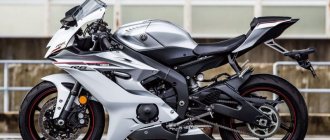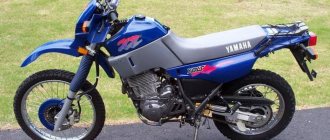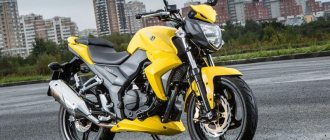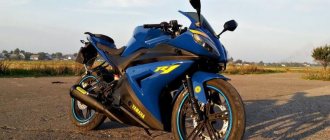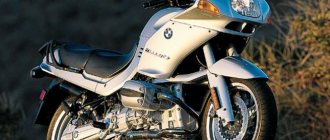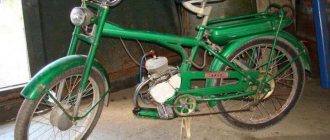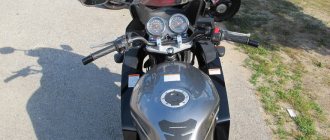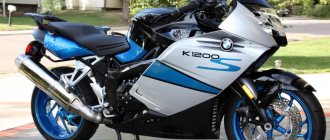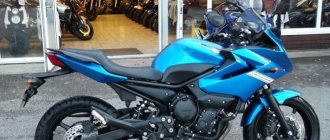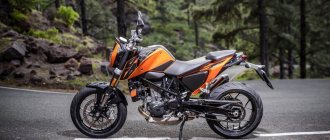This is a fairly typical naked bike, which, however, has earned popularity. An inexperienced motorcyclist may think that the model is not dynamic enough, but it’s all about the speed. At the lower end, the Yamaha FZ6 simply does not show all its abilities, but once you accelerate, the car will reveal its best side.
Of course, not everyone will like this feature, especially if we talk about connoisseurs of low revs. But a reasonable question arises: why would such people buy such a bike if they can buy themselves a good cruiser, either for the city or for the trails outside of it?
Specifications
The engine for the FZ-6 was a derated and retuned engine from the Yamaha YZF-R6 sports bike.
| Characteristic | Parameter |
| Motorcycle type | naked |
| Year of issue | 2004-2009 |
| Frame | aluminum |
| engine's type | 4-cylinder, 4-stroke, in-line |
| Working volume | 600 cc cm. |
| Bore/Stroke | 65.5 mm x 44.5 mm |
| Compression ratio | 12,2:1 |
| Cooling | liquid |
| Number of valves per cylinder | DOHC, 4 valves per cylinder |
| Fuel supply system | injector, 4x 36 mm – FZ6-N, FZ6-S injector, 4x 32 mm – FZ6-R (XJ6 Diversion) |
| Ignition type | TCI |
| Maximum power | 98 hp (72 kW) at 12000 rpm – FZ6-N, FZ6-S 77.5 hp. (57 kW) at 10,000 rpm – FZ6-R, XJ6 Diversion |
| Maximum torque | 63.1 Nm at 10,000 rpm – FZ6-N, FZ6-S 59.7 Nm at 8,000 rpm – FZ6-R, XJ6 Diversion |
| Transmission | 6-speed |
| type of drive | chain |
| Front tire size | 120/70ZR 17M/C (58W) |
| Rear tire size | 180/55ZR 17M/C (73W) — FZ6-N, FZ6-S 160/60ZR 17M/C (69W) — FZ6-R (XJ6 Diversion) |
| Front brakes | 2 discs, 298 mm, 2-piston calipers - FZ6 (2004-2007), FZ6-R (XJ6 Diversion) 2 discs, 298 mm, 4-piston calipers - FZ6 (2008-2009), FZ6 S2 |
| Rear brakes | 1 disc, 245 mm, 2-piston caliper |
| Front suspension | telescopic fork 43 mm, travel - 130 mm |
| Rear suspension | pendulum with monoshock absorber, stroke - 130 mm |
| Overall dimensions (LxWxH) | 2095 x 755 x 1085 mm - FZ6-N 2095 x 750 x 1215 mm - FZ6-S 2120 x 770 x 1185 mm - FZ6-R (XJ6 Diversion) |
| Seat height | 795 mm - FZ6-N, FZ6-S 785 mm - FZ6-R (XJ6 Diversion) |
| Gas tank capacity | 19.4 l - FZ6-N, FZ6-S, FZ6 S2 17.3 l - FZ6-R (XJ6 Diversion) |
| Maximum speed | 219.3 km/h |
| Acceleration to 100 km/h | 3.8 sec |
| Motorcycle weight (curb) | 201 kg / 206 kg - FZ6-N / FZ6-NA 207 kg / 212 kg - FZ6-S / FZ6-SA 205 kg / 211 kg - FZ6-R (XJ6 Diversion) / ABS |
Engine and transmission
Left view.
Right view.
- The motorcycle is driven by 600 cc four-cylinder DOHC engine, 4 strokes.
- The motor is tilted forward.
- Compression ratio approx. 12:1.
- At 12,000 rpm of the crankshaft, the engine develops power of 98 “horses” and 52 Nm at 10,000 rpm.
Versions FZ6-R, XJ6 Diversion - 77.5 hp. at 10000 rpm .
Rags to prevent debris from getting into the injector.
Pastels with camshafts.
And these are valves - 4 for each cylinder.
Acceleration to hundreds and fuel consumption
Average acceleration to 100 km/h is 3.8 seconds , and fuel consumption is an average of 6.5 liters .
Lubrication and ignition system
- The lubrication system has a 3.4-liter , an injection power system, and a wet multi-plate clutch.
- The ignition system is transistor battery and is reliable due to the absence of moving parts.
Two-level saddle with comfortable passenger handles.
Stylish chrome-plated “silencers”.
Transmission
Six-speed constant mesh gearbox. Chain wheel drive.
Frame and suspension
The FZ6-N frame is made of diamond-shaped die-cast aluminum.
During the repair process, we change the chain with tensioner.
The front suspension consists of a telescopic fork with a travel of 130 mm. The rear suspension is a pendulum arm with 130 mm of travel.
Brakes
There are good front double disc brakes here.
Front double-disc brakes with a radius of 298 mm and rear single-disc brakes with a radius of 245 mm .
The motorcycle is notable for the fact that the front and rear tires differ in size (front 120/70 , rear 180/55 ), the wheel radius is 17 inches .
Clearance and mass
Ground clearance 140 mm .
The weight of the motorcycle with ABS is 185 kg , and 5 kg less without ABS.
Motorcycle modifications
- XJ6 N , naked version, produced from 2009 to 2021. It cost less than all the others and was distinguished by the absence of a plastic body kit.
- The XJ6 S , or SA (for some markets), was produced at the same time. It had a developed front fairing at the front, but otherwise corresponded to the previous modification.
- XJ6 F (2010-2017). Technically, it is a complete analogue of the above versions, but the Yamaha XJ6 Diversion F is distinguished by a full set of plastic, which makes it look like a sportbike. In the USA, this modification was sold under the name FZ6 R.
Review
What do we see here?
What catches your eye is the large fuel tank , which covers the aluminum frame of the motorcycle. Due to the fact that the engine sits quite tightly, there are no gaps. The front light has an interesting triangular shape with curves.
The Yamaha's speedometer is not located in the middle, but slightly to the side. Interestingly, when the engine is turned on, a self-test is first carried out , after which the engine starts, which is almost inaudible at idle.
Controllability
At high speed, it is quite easy to control the motorcycle, despite the weight of 180 kg, and the ride feels comfortable, thanks to the long-travel fork.
Bikers note easy maneuvering in traffic jams and stable cornering stability.
All controls respond to commands quickly, so you can safely concentrate on the road situation. Comparing this model with one, one feels that changing gears has become much easier, and a characteristic click is not heard when shifting. The riding process of the Yamaha FZ6-N has become a little better compared to the previous line of motorcycles.
Instrument cluster
The instrument cluster is completely electronic.
Digital instrument panel.
If at high speed the speed indicator is easy to read, then the tachometer clearly loses in this regard, since a narrow strip is allocated for it on the LCD display. By the way, this model received adaptive light , and now the low beam turns on automatically. The introduction of this technology was facilitated by changes in legislation.
FAQ
- Are the spare parts for Phasers and Diversions interchangeable? Yes, many internal components are suitable. Moreover, some parts are standardized with other models of the manufacturer.
- Is it possible to take the plastic from a Yamaha XJ6 Diversion F and put it on a naked version? Yes, but a lot of things will have to be “finished with a file”, since there are no fastenings for the plastic body kit on naked bikes. Yes, and such an undertaking will cost a tidy sum.
Advantages
- Excellent traction throughout the entire rev range and in all gears, the motorcycle easily reaches the 200 km/h mark.
- Successful tuning of the suspension and braking system.
- Reliable and powerful motor.
- One of the best motorcycles for city riding.
The fairing provides good protection at 100 km/h or more.
The light from the slanting headlights is quite bright and open.
and disadvantages
- Heavy weight.
- The mirrors are too small for visibility.
49CS6334
However, despite the unremarkable engine, mediocre chassis and frankly weak brakes, Diversion was popular. Note that the motorcycle was produced for 19 years without significant changes! One of the main reasons for the consistently high demand is the very, very reasonable price for any version. All these conflicting impressions from the previous generation of “saboteurs” swarmed in my head when I took the new XJ6 Diversion for a long test - although Yamaha representatives insisted that this motorcycle was not like that at all.
Who is this bike suitable for?
This motorcycle is recommended for those who already have sufficient experience in driving powerful motorcycles.
The Yamaha FZ-6 road bike is a fairly popular model and a prominent representative of the class of 600 cc classic motorcycles.
Since the motorcycle weighs 180 kg, it is best to have experience in driving heavy motorcycles . Regarding power: 98 horsepower, this is the power that you need to be able to handle carefully . Considering the specialization of the motorcycle as a city transport, we do not recommend that beginners get behind the wheel of the FZ6 bike.
This motorcycle is suitable for experienced motorcyclists who cover more kilometers in city mode and value quality and reliability , as well as comfort. Even after several hours of continuous driving with a passenger, you will not feel tired.
Design
Since the Yamaha XJ6 was developed on the basis of the FZ-6, similar features can be traced in the appearance of these two models. This did the bike good; it looks great even by modern standards, and doesn’t seem like something from the distant past. This is doubly true for modifications with a plastic fairing, which in full view resembles its brothers in the YZF sports bike line. A successful combination of sporty and classic features has given the Yamaha Diversion a very harmonious and balanced appearance .
How to choose the right one
Since the motorcycle has not been produced for a long time, in any case, they are all used. Choosing a specific model is not easy, since most of them have been involved in accidents and are damaged.
What to pay attention to
- A price below $3,000 indicates that the motorcycle has or has had serious damage, or has problematic documents. In other words: a motorcycle requires an investment.
- If you find an advertisement and “take an eye” at a specific option, then compare it with the original photograph of a motorcycle of the same model in order to visually determine either the absence of any decorative details, or the presence of a “collective farm”.
- Things like a headlight, pendulum, seat, subframe, fork, brake system must be original, and not a Chinese analogue . If there are obvious points for installing Chinese analogues, then this is a good reason to bargain.
- Chinese plastic is not sold for the FZ6 model, so there is no need to worry about the originality of the linings.
- The presence of small scratches on the weights of the handles, turn signals and plastics indicates minor accidents that should not be paid attention to, since this is a typical situation for a motorcycle of this class. If the motorcycle fell at speed, then the scratched sidewall will tell you about it.. Often, after such accidents, motorcycles are sold, and the amount of restoration may be insignificant, provided that the scratches are not deep, the tank is not dented, and the gaps between the plastic are within tolerances.
Inspect the handles for deep scratches and cracks.
- Be sure to check, wherever possible, the motorcycle for the number of accidents, as well as the correspondence of the frame number with the number recorded in the technical passport of the vehicle.
- Ask the seller to remove the plastic that covers the battery niche. The plastic should be easy to install back . Any difficulties indicate the presence of an accident. And also ask to remove the lining of the drive star. If it is dirty, but the motorcycle is clean, then judge how good the other components and assemblies are.
Owner reviews
The Yamaha XJ6's performance, of course, is not great, but the bike is still peppy, balanced and very comfortable. I owned the full plastic version for two years, the ride is comfortable, the seating position is almost straight, and not like on sports bikes, my back and arms don’t get tired. The standard wind deflector is enough for up to 150-160 km/h, and you don’t need more; in extreme cases, you can lie down on the tank. I traveled around the city to work constantly, plus evening errands and trips to the sea once or twice a season. With a passenger, a topcase and two textile side cases at a speed of 120-130, the consumption is less than a liter more than alone. I wouldn’t have parted with the moto, but I suddenly needed money, I had to walk for one season, and then I bought a new FJ-09, which Tracer is also happy with as an elephant. Ilya, Moscow.
When I was choosing between Hornet, Bandit and Diversion and reading tons of reviews, I almost went crazy, but in the end I still took the Yamaha and did not regret it. The engine is fire, overtaking is easy at any speed, there have not been a single breakdown in 30k miles. The downside is that the engine is noisy; if you travel long distances, I really recommend either buying an integral with good noise, or putting earplugs in. And the standard glass on the Yamaha XJ6SA is not suitable for pilots taller than 180-185 cm, the wind blows right into the head, so tall riders need to place the glass higher. Arthur, Krasnodar.
The bike handles beautifully; once, at the exit of a long turn at a speed of under 120, I caught a wobble and almost gave birth to a hedgehog. It’s not my first year behind the wheel, I know what to do, so I just let the XJ 6 straighten itself out. And so it happened, Diversion simply caught the road and moved on as if nothing had happened. He really forgives mistakes, although the stupidity is enough for instant teleportation to the next world, so we still don’t turn off our heads, gentlemen motorcyclists. Evgeniy, Omsk.
Tips for maintenance and upkeep
- The motor here is simple and very reliable . It starts well in any weather provided the battery is charged. It is better to change the air filter once a season, and the oil once every 5000 km.
- Pay attention to the thickness of the brake discs. They wear out very slowly, but a new set costs an average of $150. If there are just a few millimeters left of the pads, change them immediately.
- Check the chain for stretch .
It may stretch unevenly. Inspect the chain before purchasing - ALWAYS! - When you start the engine, “Check” will light up for a few seconds, but this does not indicate any malfunction in the engine.
Watch the chain - you can’t ride with that much slack!
The chain can stretch so much that it falls off the rear sprocket and there will be consequences, as in the photo below:
The chain broke off a piece of the crankcase.
Now only welding will help.
Argon welding is not cheap!
Average prices for spare parts
A broken or broken chain can cost you $150–200.
Since the exchange rate of the ruble against the dollar is constantly changing, it is better to know prices in foreign currencies.
- straight-through exhaust system 500–600$.
- star chain 150–200$.
- rubber 100–130$.
- front pads $20 , rear pads $60 .
- oil 50$.
- original air filter 25$.
- spark plug set 30$.
- timing chain kit with tensioner 150$.
When replacing a chain, the main thing is not to break the sprocket bolt!
Motorcycle price
Now this model is no longer produced, so you can become its owner only by purchasing it from someone else. The cheapest offers start at 260-280 thousand rubles , and the most expensive ones are offered for 500-530 thousand . The average price is about 350 thousand rubles, for this money there is a wide choice.
49CS6206
I decided to evaluate the engine and brakes upon arrival in the capital - after running in the power unit and final grinding in of the pads. The new engine impressed with its torque and elasticity. It feels like the torque characteristic has been spread evenly across the tachometer. On the highway, sixth gear can be engaged already at 85–90 km/h and even overtaking in it. After running in, I checked the “maximum speed” - the digital speedometer showed 215 km/h. However, by the end of the two-month test, when the mileage was more than five thousand kilometers, the maximum speed increased to 221 km/h. But with a passenger, the motorcycle refused to go more than 195 km/h (unlike the passenger!) - well, the aerodynamics of the vehicle (and, therefore, the “maximum speed”) are largely determined by the weight and dimensions of the crew (and cargo). So, perhaps some Japanese guy and his girlfriend will squeeze even more than my “single” maximum. But the Diversion becomes very willing to use the rear wheel.
49CS6187
During the test, I was able to not only give rides to my five-foot-tall friends and petite girlfriends, but also to evaluate the passenger seat myself. It turned out that riding as number two on this motorcycle is almost more pleasant than being the driver. It is noteworthy that while I was driving, I did not experience any discomfort from the fellow passenger behind me, regardless of his height. The ergonomics of the “second number” are thought out in such a way that it absolutely does not constrain or limit the driver’s movements either on the highway or in traffic jams. The only thing that had to be adjusted in the motorcycle was “clamping” the spring of the rear shock absorber. Fortunately, this is convenient to do, and a special key is present in the included tool kit.
49CS6259
After arriving at my destination, I gave the ergonomics of the driver’s seat an “excellent” rating. You feel “at home” on this motorcycle: a comfortable high handlebar, a wide and soft seat, low footrests - all this makes any ride very pleasant. Despite the strong side wind that accompanied me all the way to Voronezh, I covered more than five hundred kilometers without getting tired. By the way, both a tall kid like me and a short girl can comfortably fit in a low saddle (it was not difficult to find a standard miniature biker at the festival). Well, things were good with ergonomics on the old “Diversion” as well. And I like the wind protection in the new version much better.
49CS6209
In the end, it turns out that the Yamaha people were right when they said that the new “Diversion” is not at all similar to the previous one. This is an incredibly beautiful and fast bike that handles, rides and brakes well. Diversion will be a good help in mastering the world of motorcycles; I won’t be afraid to recommend it to beginners. The only thing that the new generation has in common with the one that was recently discontinued is a very “tasty” price, which is very useful in today’s difficult times.
The motorcycle for testing was provided by Yamaha Motor CIS.
49CS6193
The bike performed even better in the city than outside of it. Short passes, which I so wanted to “stretch” on the track, come in handy here. The device demonstrates very good dynamics, and the small width of the fairings and the huge steering angle make the process of piercing plugs almost the most enjoyable experience in the world. “Sabotage” made it possible, without even straining, to stay behind the motards in city traffic. True, only when they were moving along the roadway. The work of the suspensions caused only positive emotions. Even in the absence of adjustments (except for the spring preload of the rear shock absorber), they work out large irregularities well, and you hardly notice small ones at all (note: I weigh a hundredweight in the equipment!).
